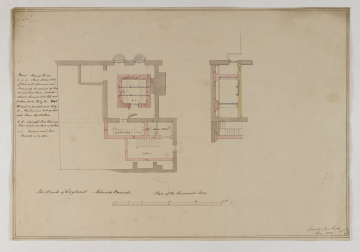
Browse
Reference number
Purpose
Aspect
75 Plan of the Basement Story with section through treasure vault and steps to ground floor
Scale
Inscribed
75 as above, The Bank of England, Norwich Branch, Mem Strong Room // a.a.a. These spaces to be / filled with framed wrot / Ironwork to consist of Inch / round Iron Bars, 6 inches / apart, framed into top and / bottom rails 1½ by ¾ - to pass / through a middle rail 2½ by / ½ - the framing to be caulked / into Stone top & bottom // b.b. Wrought Iron Bearing / Bars 4'' by 1½'' caulked into Stone // c.c. Framed wrot Iron / Guards as heretofore, labelled: Cellar, Wine Cellar, York Stone Steps & Landing, No Door, Iron Gate, Iron Door, Stone, Ironwork, Joists, 6 York Landing, lettered: a (3 times), b (twice), c (twice)
Signed and dated
- (74) 26th March 1829 (75) Lincolns Inn Fields / May 1829
Medium and dimensions
Hand
Notes
The Soane office Day Books record C. J. Richardson, one of Soane's pupils, making a 'drawing of vault at' (sic) on 19 March 1829. The unmentioned location is surely Norwich.
Level
Sir John Soane's collection includes some 30,000 architectural, design and topographical drawings which is a very important resource for scholars worldwide. His was the first architect’s collection to attempt to preserve the best in design for the architectural profession in the future, and it did so by assembling as exemplars surviving drawings by great Renaissance masters and by the leading architects in Britain in the 17th and 18th centuries and his near contemporaries such as Sir William Chambers, Robert Adam and George Dance the Younger. These drawings sit side by side with 9,000 drawings in Soane’s own hand or those of the pupils in his office, covering his early work as a student, his time in Italy and the drawings produced in the course of his architectural practice from 1780 until the 1830s.
Browse (via the vertical menu to the left) and search results for Drawings include a mixture of Concise catalogue records – drawn from an outline list of the collection – and fuller records where drawings have been catalogued in more detail (an ongoing process).






